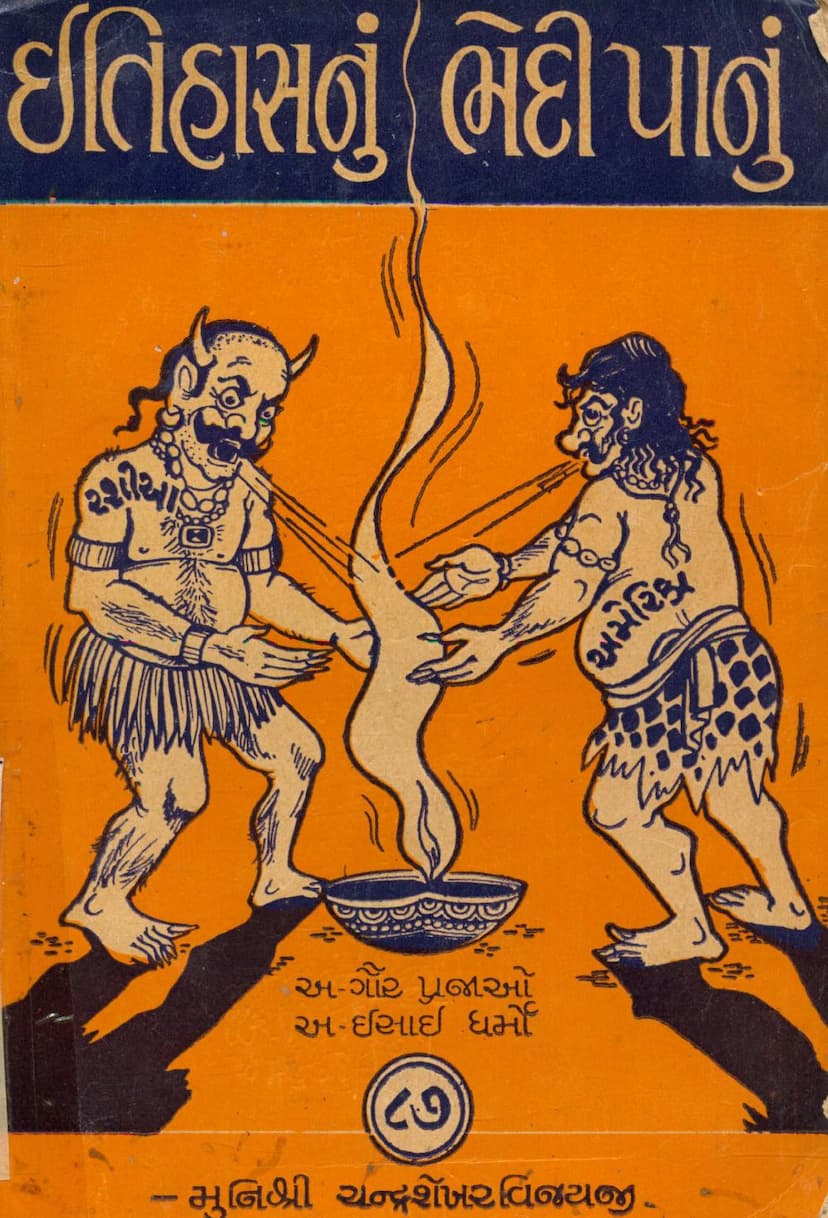Itihasnu Bhedi Panu
Added to library: September 1, 2025

Summary
Here's a comprehensive summary of the Jain text "Itihasnu Bhedi Panu" (A Secret Page of History) by Munishri Chandrashekharvijayji, based on the provided pages:
Overall Theme:
The book argues that Western powers, particularly the "fair-skinned" races (Gora Praja), have employed a subtle, multi-faceted, and destructive strategy over the past 500 years to undermine and ultimately eradicate non-Western cultures and religions. This strategy, disguised as progress and development, aims to establish their own global dominance. The author contends that this agenda is still active and poses a grave threat to Indian culture and spirituality.
Key Arguments and Concepts:
- The "Secret Policy" (Bhedi Niti): This is the central concept. It describes a hidden, insidious plan by Western powers to dominate the world not primarily through outright warfare, but by systematically destroying the cultures and traditions of non-Western societies.
- Erasure of Non-White Races and Non-Christian Religions: The core objective is to eliminate all non-white races and non-Christian religions from the face of the earth.
- Methodology: "Divide and Destroy" (Chiro, Vikas, Bhelsel, Ekta): The book outlines a four-pronged strategy:
- Divide (Chiro): Creating divisions within societies and cultures. This is done by sowing discord, creating factions, and exacerbating existing differences (e.g., between Hindus and Muslims, Brahmins and Harijans, different Jain sects, or even within a single person's beliefs). The goal is to weaken the target group by fracturing it.
- Develop (Vikas): This is a deceptive phase. "Development" is presented as progress, but in reality, it's a tool to undermine traditional structures. This includes promoting Western education, lifestyle, and economic models, which gradually erode indigenous values and practices. Examples include the demeaning of traditional Indian knowledge systems like Ayurveda, the creation of dependency on foreign goods, and the promotion of Western-style governance.
- Mix/Adulterate (Bhelsel): Introducing foreign or corrupted elements into the original culture. This involves diluting core religious practices, promoting superficial spirituality, and encouraging syncretism that weakens the original faith. The author points to the influence of Western scholarship on Indian texts (like the Vedas and Jain scriptures) and the rise of groups that superficially adopt Indian practices while promoting Western values as examples.
- Unite (Ekta): This is the final destructive phase, where the weakened and corrupted elements are brought together under a false unity. This unity, often presented as progress or peace, is actually designed to complete the destruction of the original culture by assimilating it into the dominant Western framework, often under the guise of religious tolerance or global harmony. The author critiques modern concepts of global unity and secularism as tools for this assimilation.
- The Role of "Native Englishmen" (Deshi Angrezo) / Agents: The strategy relies heavily on co-opting educated elites from within the targeted societies. These individuals, often educated in Western institutions, become agents who unknowingly or knowingly carry out the Western agenda, dismantling their own cultures from within. They are presented as "big brothers" or leaders, but their true purpose is to serve foreign interests.
- Historical Precedents: The book references historical events, starting from Vasco da Gama's arrival in India and the Papal Bull that divided the world between Portugal and Spain, as evidence of this long-standing Western ambition. It also critiques the influence of figures like Max Müller and the establishment of Western-funded "chairs" in universities as part of this strategy.
- Critique of Gandhi's Philosophy and Indian Governance: The author, while acknowledging Gandhi's initial ideals of promoting Indian culture, suggests that his later embrace of Western parliamentary democracy and certain aspects of his philosophy were co-opted by the British and ultimately proved detrimental to Indian culture and spirituality. He argues that the current Indian democratic system and elections are not inherently suited to Indian life and lead to party politics and discord.
- The Threat to Jainism: A significant portion of the book is dedicated to analyzing how these Western strategies are being applied to Jainism. The author argues that divisions within the Jain community (Chiro), the promotion of superficial religious practices or philosophical interpretations (Vikas), the dilution of core tenets (Bhelsel), and the push for an artificial unity that undermines core principles (Ekta) are all part of a deliberate effort to weaken Jainism. He warns that this could lead to the loss of its unique identity and the erosion of its spiritual core.
- Call for Revival and Vigilance: The book concludes with an urgent call for Jains and Indians in general to recognize these insidious strategies, reassert their own cultural and religious values, and unite to protect their heritage. True strength, according to the author, lies in adhering to authentic religious practices and principles, not in superficial unity or compromise that weakens the core.
In essence, "Itihasnu Bhedi Panu" presents a stark warning about a centuries-old conspiracy by Western powers to systematically dismantle non-Western cultures through deceptive means, portraying "progress" and "development" as the Trojan horses for cultural annihilation. The author uses historical examples and analyzes various societal and religious trends to support his thesis, urging readers to be vigilant and protect their indigenous heritage.